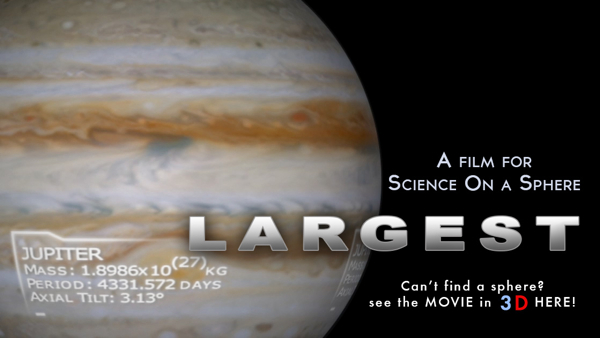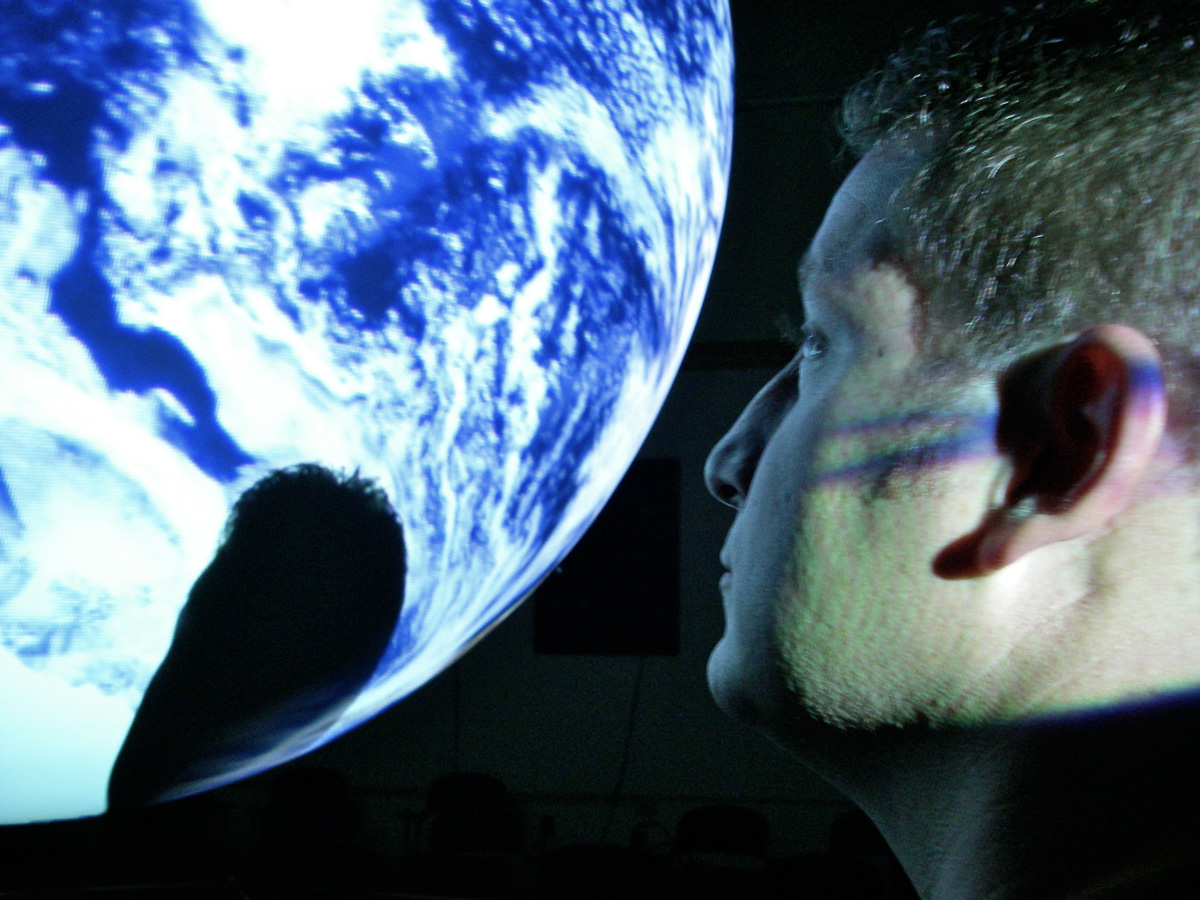Portfolio Overview: Spherical Media
Victoria Weeks' spherical filmography includes Footprints (2006), Energy Planet (2008), Frozen (2009), Return to the Moon (2009), Largest (2009), Energy Revolution (2009), Loop (2011) and Water Falls (2014).
Many are represented here, and available to watch online.
This section covers our team's work on spherical films. For more about our work in HD, 4K, 3D and print media, please check out our rectangular media portfolio page.
What exactly is Science On a Sphere? Also known as SOS, it’s a striking spherical display found in museums, science centers and atriums all over the world. The display technology was developed by the National Oceanic and Atmospheric Association (NOAA). It harnesses 4 projectors, multiple GPU’s and a 6-foot spherical screen hanging in the center of the room. It all comes together via custom software, allowing for a full 360 degree seamless panoramic experience of global data sets, real time interaction and even movies.
Movies!
That’s where Verglas Media comes in. We have a unique background that allows us to specialize in creating spherical movies and related content. Our team understands the challenges and has pioneered many of the solutions for working on the sphere. While not all rules of traditional flat-screen filmmaking are checked at the door, many are. You have to know how to think spherically, let alone photograph, edit and animate spherically.
Our Pale Blue Dot is the first independent film created for Science On a Sphere, and was produced by Verglas Media.
Be sure visit the film’s webpage to watch the trailer and learn about our inspiration to create the film. We also provide access to in-depth resources about the imagery and visualizations used to create the movie.
Victoria Weeks' spherical filmography includes Footprints (2006), Energy Planet (2008), Frozen (2009), Return to the Moon (2009), Largest (2009), Energy Revolution (2009), Loop (2011), Water Falls (2014) and Our Pale Blue Dot (2014).
Many are represented here, and available to watch below.
WATER FALLS (2014)
See NASA’s Science On a Sphere (SOS) movie introducing the public to the Global Precipitation Measurement (GPM) satellite mission. This film was made to raise awareness leading up to the February 27, 2014 launch of the GPM Core satellite. It aims to engage the viewer in thinking about the vital role of fresh water in our daily lives.
LOOP (2011)
Loop showcases the high-tech remote sensing and modeling that NASA is famous for, and contextualizes it via stunning full-wrap real world imagery. Science On a Sphere is a perfect platform to tell this story, as global winds and ocean patterns can be fully visualized, along with concepts such as the Coriolis effect and the endless cycle of Daisyworld.
FROZEN (2009)
One of the first films ever made for the Science On a Sphere (SOS) platform, Frozen uses a plethora of data to discuss the realities of our planet's frozen regions. While most of those regions are not typically in our everyday experience, it turns out they effect us all. NASA and its partners have been observing these changes, from space, of course, for decades. What has the data revealed?
LARGEST (2009)
Jupiter - the largest planet in the solar system with a gravitational field to match. See it compared to Earth, learn about its dozens of moons, see its ancient red storm up close. Watch the planet capture and destroy a comet. Jupiter. It's good to be king.
ENERGY REVOLUTION (2009)
This film highlights the ambitious technologies that the U.S. is pursuing regarding high-tech smart-grids and smart-buildings, along with various renewable energy sources, such as cellulosic ethanol and wearable, thin-filmed solar cells. And that's just a taste of what's possible, all of which could lead to better climate strategies for the whole planet.
FOOTPRINTS (2006)
Footprints is the first film ever produced for Science On a Sphere, and was created at the NASA Goddard Space Flight Center. In only 16 minutes, Footprints moves from Earth, through our solar system and into the universe beyond. It's a cutting edge movie….but without actual edges.
What exactly is Science On a Sphere? Also known as SOS, it’s a striking spherical display found in museums, science centers and atriums all over the world. The display technology was developed by the National Oceanic and Atmospheric Association (NOAA). It harnesses 4 projectors, multiple GPU’s and a 6-foot spherical screen hanging in the center of the room. It all comes together via custom software, allowing for a full 360 degree seamless panoramic experience of global data sets, real time interaction and even movies.
Movies!
That’s where Verglas Media comes in. We have a unique background that allows us to specialize in creating spherical movies and related content. Our team understands the challenges and has pioneered many of the solutions for working on the sphere. While not all rules of traditional flat-screen filmmaking are checked at the door, many are. You have to know how to think spherically, let alone photograph, edit and animate spherically.
Victoria Weeks, owner of Verglas Media, has been at the forefront of spherical filmmaking since 2006. As editor and motion graphics artist for Footprints, the first film ever made for SOS by NASA, she has been discovering techniques and honing her skills on the round screen. In total, she has filmed and edited six films for NASA as well as two for the Department of Energy. As she continues producing films independently, her goal remains the same: to capture and inspire audiences through the partnership of art and science.
If you would like to see these films on the sphere, as intended, check out NOAA’s list of SOS locations and find one near you. We have also rendered many of the movies to a virtual sphere so you can get a taste of the work via YouTube.
Be sure to check out our blog post and gallery to get a visual perspective on SOS!
Almost an astronaut. Almost. Get the story of how SOS works in pictures HERE.







